It’s been over a year since web push notifications were introduced by Google with Chrome 42. Since then, close to 100K websites are now actively using web push notifications. Over 10Bn Chrome Notifications are being pushed every day. While adoption has been crazy, the question of the impact of web push implementation on SEO exists in minds of marketers. Well, here is the short answer – No. There is no negative impact of implementing web push notification. The fact that Google has been pushing for it aggressively, definitely suggests that there is no possible negative impact. As per this webmaster forum thread, the answer is no but again there can be a significant potential upside of web push notifications on your SEO.
Here’s a breakdown of how you can use web push notifications to improve your overall SEO.
Quick Brief About Web Push Notifications
Web push notifications are clickable messages sent to a browser on your device. These notifications can only be sent to users who have subscribed for these notifications. As these notifications are pushed by browser, subscribers don’t have to be present on your website to receive these notifications. Users can subscribe and receive these notifications on mobile, desktop and tablet.
What can web push notification help you achieve?
As a marketer, web push notifications can help you accomplish two key things:
- Build A Marketing List for Mobile and Desktop: Browsers require users to subscribe to push notification – while the subscription itself is only a Allow / Block choice, it helps you convert your web traffic into subscribers. Subscription rates can vary from 5% to 25% depending on how you implement. Simply put, you can build a notification subscriber base at a rocket speed as compared to Email. The basic lead capture forms struggle to put a conversion rate of 4-5%. Here is how web push notifications have performed when compared with email for Trak.in, a leading news website in India.
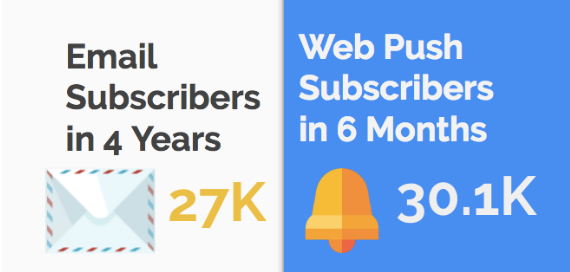
- Driving Repeat Traffic: Because web push notifications are delivered directly to the device, they attract a response rate which is far higher as compared to email. The average CTR as measured over 200 Businesses ( publishers, advertisers ) and 26 Million Notifications is about 5%. Compared to email, this is almost 10X. It is because of these numbers, web push notification is now one of the highest contributor under the repeat traffic tab – higher than email or social.
Can Web Push be that integral part of your SEO Strategy
Let us take up each metrics individually and see how web push notifications have worked for various leading brands and how it help start contributing to your overall SEO.
Website Traffic
Website traffic as we know, is one metric that makes or breaks your site. Even SEO efforts are now tailored to serve users first. This metric can be broken down into two segments:
- New users – Read this brilliant piece on new user acquisition strategy from Neil Patel here.
- Repeat Users and Repeat Traffic – This is one metric that you can start improving using web push notifications.The importance of repeat users is undeniable and so is the fact that your returning users may have a significant ability to attract new customers for you.
Marketers who leverage their returning customers to drive acquisition efforts can see an ROI of up to 15x, compared to only 4–6x ROI for traditional acquisition campaigns – Harvard Business Review
Trak.in, a leading new and business website, now drives as much 30-40% repeat traffic via web push notifications.
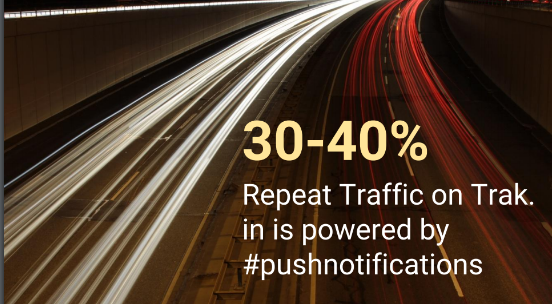
Even e-commerce marketers are leveraging web push to drive repeat traffic and generate incremental sales. For instance, FreshMenu, a leading food delivery business, uses their on site behavior data to push personalized notifications. End Result – 12% of Sales of FreshMenu are generated using web push notifications.
What are other critical metrics that you need to measure and track ?
Repeat traffic helps you drive significant value to your overall SEO strategy. Now there are definitely qualitative metrics to evaluate the quality of web traffic. Quality being determined from 3 key things:
- Bounce Rate
- Average Session Duration
- Page Views
We analyzed impact of web push notifications on the bounce rate for a leading coupon site – CouponzGuru and compared it with across three different sources:
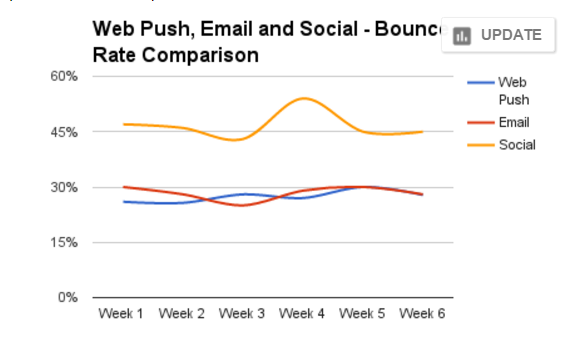
Repeat traffic generated from channels such as Email and Web Push clearly performs better. Even Koovs, a leading online fashion store, saw a 12 % drop in the bounce rate for the traffic that they brought in from web push notifications, as compared to other channels.
Page Views and Session duration
The number of page views and session duration are other metrics that we need to focus on while measuring our SEO efforts. Super coder and Couponzguru are two leading coupon sites which have experience the impact of web push notifications on their page views and session duration as compared to other user-engagement platforms.
Let me share some data with you.
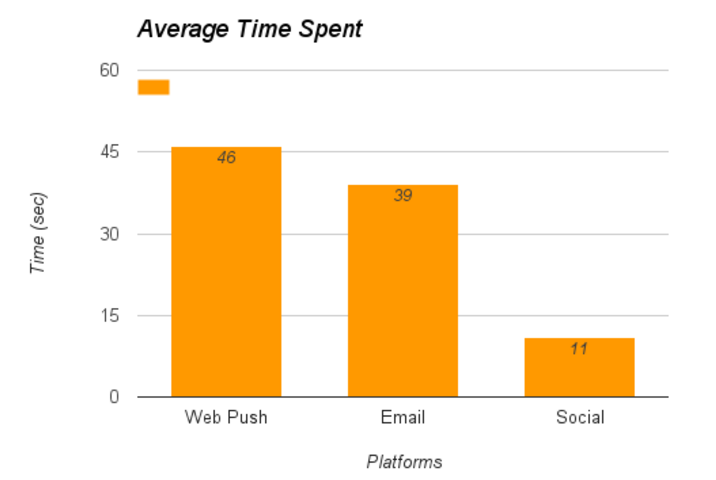
Here, we can clearly see that the average time spent (avg. session duration) for Supercoder is much higher as compared to other platforms like email and social.
Again these are not benchmarks and will not apply to everyone and anyone but what can be concluded safely is that web push notifications when used in the right manner, can actually start improving your overall metrics.
Pre-Requisites: Implementing Web Push requires HTTPS
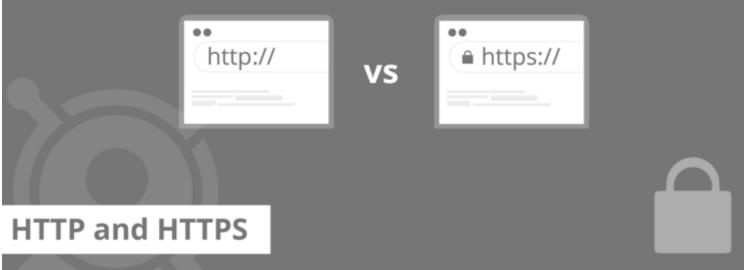
In 2014, as an effort of building a safer web Google had their HTTPS everywhere campaign when they announced HTTPS as a ranking signal and started indexing secure pages over unsecured pages.
In a recent post, the chromium blog has also made very clear that starting January 2017 (Chrome 56), HTTP pages that collect passwords or credit cards will be marked as non secure. Again, another reason which points out to the fact of web push being a positive investment for your SEO strategy.
Doing the Right Implementation
The right implementation can not only help you get more subscribers but also generate more repeat traffic, which is a critical SEO signal. While the adoption of web push has been steep, it is important to understand the concepts and understand how not to implement web push notifications. Most of the 3rd party tools trivialize the implementation by stating that all you need to do is add a js tag. There are 3 questions that you need to address for the right implementation- What, When and Where. Let’s take this up with a couple of examples.
Where – Where on the website, should you prompt the users for Subscription ?
This question might sound very abrupt to some. Specially to those who have been taking the approach of simply prompting the users at each and every web page.
Well, there’s a concept called “customerization”, you might as well want to apply it here. Won’t you? Also, if you’ll keep prompting your users on all the web pages that no doubt, your brand is going to be portrayed as ‘Spammy’ and ‘Annoying’. So, the right implementation approach here will be digging in your analytics data and choosing the pages where your users spend the highest time.
Let’s take an attempt at breaking this down categorically.

Note- These are just suggestions based on our research, you might found some other pages relevant for the consent prompt. Feel free to experiment a little.
How and When
How and when should you prompt your users for consent?
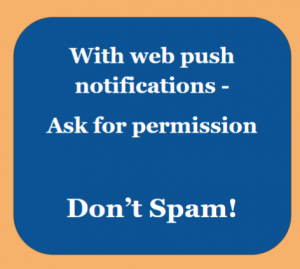
It is strongly suggested that users should only be prompted for consent once they have showed some amount of willingness towards receiving it. What this means is, ideally the consent prompt should not appear as the very first thing on the website (even before the users have actually seen the website), for this again flags your brand as spammy. To avoid this you can define a particular bar for time spent after which you want the prompt to appear. Give them some time to absorb the content you have on your site and maybe then prompt them for consent. For Instance, Setting the prompt to 15s will make sure that you prompt some of the interested users only (who are most likely to stay back on your website for long). Here are some of the recommended UX guidelines from Owen’s Google Doc.
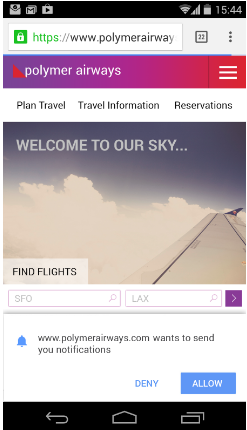
Thumb Rule- Avoid Prompting your users during the page load time.
As a best implementation practice you should also avoid showing permission prompts to users which they might not be interested in.
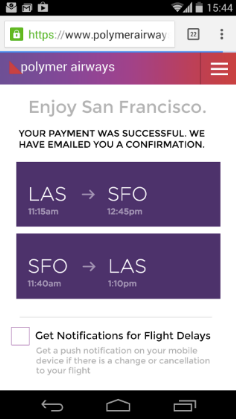
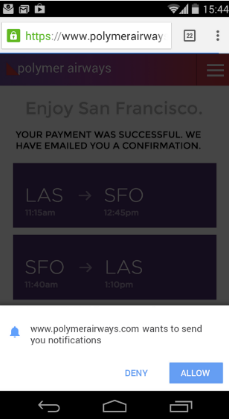
Here the site shows a clear opt-in call to action, “Get Notifications for Flight Delays” at a logical point within the flow, giving the user context for the permission prompt. When the prompt is shown, the site dims the rest of the screen to help guide the user through the flow. Look at the Owen’s document in the footer for more specific pointers.
Metrics to Track
One thing that you should always keep in mind while prompting your users is the allow to block ratio.
Quick Recap:
- Develop deep insight of your target audience;
- Segment your target audience intelligently ;
- Send contextual messages ONLY ;
- Use clear call-to-actions ;
- Trigger event and interest based notifications ;
- Use relevant icons and images ;
- Send notifications according to the subscriber’s local time zone.
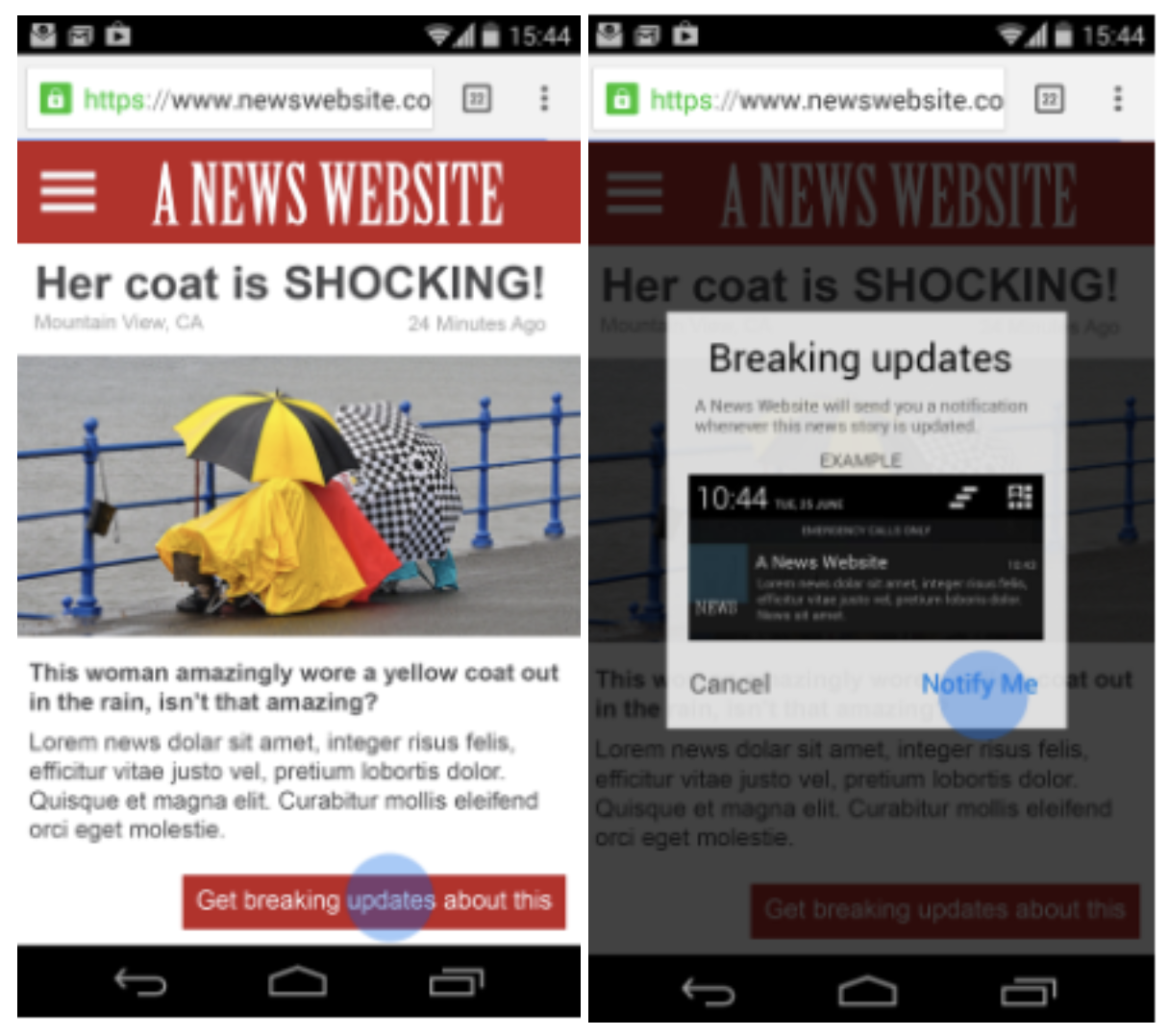
Great Example on web push notification implementation
The site showed a clear opt-in call to action. It then further explained the feature before directly requesting the permission. When it requested the permission it greyed out the remaining content, ensuring the user focuses on the permission prompt.
If you too think web push notifications should be an integral part of your SEO strategy, then give it a spin.

